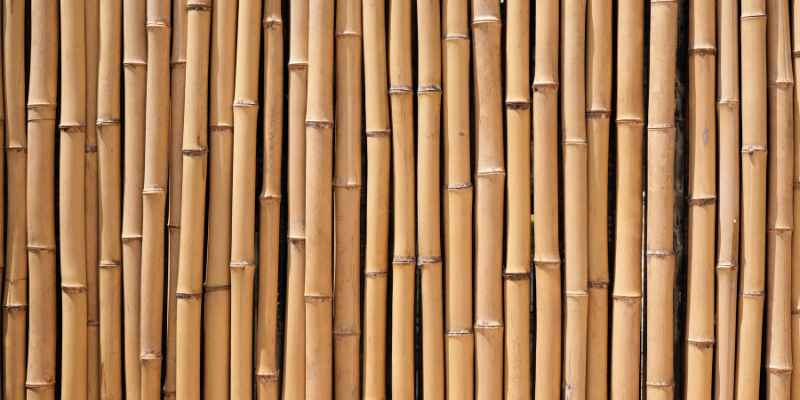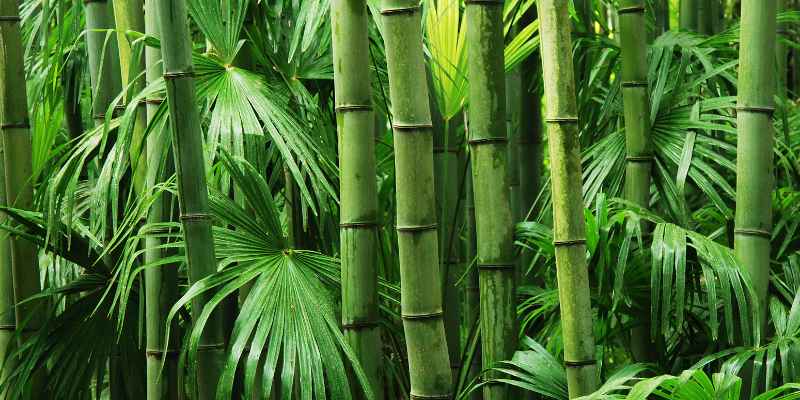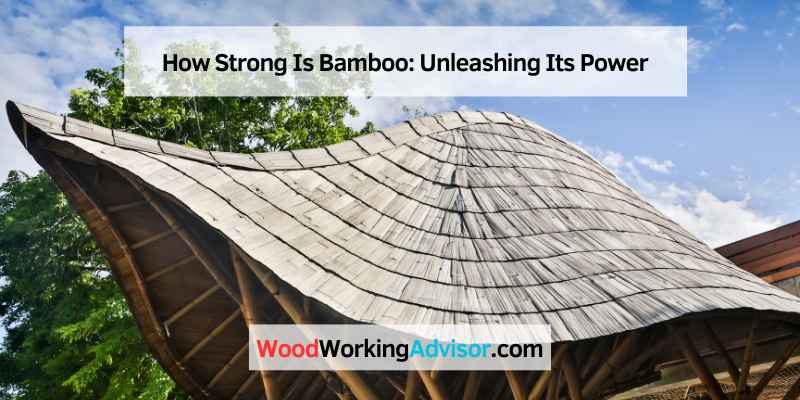Bamboo is a highly strong and durable natural material used for various purposes due to its impressive tensile strength and flexibility. With a maximum of 20 words per sentence, the following is a well-rounded introduction to the topic: Bamboo, a natural material known for its strength, proves to be impressively durable and flexible.
With its high tensile strength and various applications, bamboo has gained popularity in construction, furniture making, and even as an eco-friendly alternative. This versatile plant, abundant in Asia, possesses qualities that make it comparable, if not superior, to traditional building materials.
Its remarkable strength allows it to withstand heavy impact and pressure, making it a reliable choice for various structures. Additionally, bamboo’s rapid growth rate and renewability contribute to its sustainable appeal.
The Strength Of Bamboo
Bamboo is not just another plant that adds beauty to your garden, it is a natural wonder with remarkable strength. Its unique characteristics make it one of the strongest plant-based materials on the planet. From its composition to its impressive applications in construction, let’s explore the strength of bamboo in detail.
Natural Characteristics
Bamboo owes its exceptional strength to its natural characteristics. The secret lies in its composition, which consists of strong fibers intertwined within the plant’s structure. These fibers give bamboo its impressive tensile strength, making it resistant to bending and able to withstand heavy loads without breaking.
Furthermore, bamboo is incredibly flexible due to the high elasticity of its fibers. This flexibility allows bamboo to withstand strong winds and earthquakes, making it an ideal material for areas prone to natural disasters. Additionally, its natural moisture resistance and durability make it resistant to rot, fungal infestations, and pest damage.
Comparative Strength
When compared to other construction materials, bamboo exceeds expectations. In terms of strength, bamboo rivals steel, as it has a higher tensile strength than many alloys of steel. While steel construction demands high energy consumption and extensive processing, bamboo requires far less energy during production, making it an environmentally friendly alternative.
Moreover, bamboo surpasses the strength of traditional building materials like wood and concrete. Its combination of strength, flexibility, and light-weight nature makes it an excellent choice for a wide range of applications.
Applications In Construction
The strength of bamboo has made it a popular choice in construction, particularly in regions where it is abundant. Its exceptional properties allow for a variety of applications such as:
- Structural elements: Bamboo can be used for columns, beams, and trusses in buildings, providing strength and stability.
- Flooring and decking: Bamboo flooring is renowned for its durability and aesthetic appeal, offering a sustainable alternative to traditional wooden flooring.
- Wall panels: Bamboo wall panels not only add a touch of elegance to interior design but also provide excellent insulation and soundproofing properties.
- Furniture: Bamboo furniture combines strength and style, providing a sustainable option for interior decor.
- Bridges and scaffolding: Due to its strength and flexibility, bamboo is used in the construction of temporary bridges and scaffolds, offering cost-effective solutions.
As we can see, the strength of bamboo opens up a world of possibilities in construction, presenting a viable alternative to conventional materials.
Overall, bamboo’s natural characteristics, comparative strength, and versatility in construction make it a powerful and sustainable material choice. Its strength not only lies in its physical attributes but also in its potential to revolutionize the way we build. Embracing bamboo as a construction material can lead us towards a more sustainable and resilient future.

The Science Behind Bamboo‘s Strength
Bamboo exhibits exceptional strength due to its unique fiber structure, making it stronger than many traditional building materials. Its natural resilience and flexibility allow it to withstand heavy loads and high winds, making it an ideal choice for construction and other structural applications.
Fiber Structure
Bamboo’s impressive strength can be attributed to its unique fiber structure. Unlike wood, bamboo is composed of long, straight fibers that are tightly packed together, giving it incredible rigidity. These fibers, known as vascular bundles, run the entire length of the bamboo culm, providing structural support and preventing the plant from bending or breaking easily. The compact arrangement of these fibers contributes to bamboo’s high tensile strength, making it an ideal material for various applications, from construction to furniture.
Lignin Content
Lignin, a complex organic compound found in the cell walls of plants, plays a significant role in determining bamboo’s strength. While wood contains a high percentage of lignin, bamboo has a lower lignin content, which contributes to its greater resilience and flexibility. This reduced lignin content allows the bamboo fibers to withstand bending stresses without breaking, making it highly resistant to cracks and fractures. Additionally, the absence of excess lignin also makes bamboo less susceptible to insect infestation and rot, further extending its lifespan and durability.
Mechanical Properties
Bamboo possesses remarkable mechanical properties that contribute to its overall strength. Its high tensile strength allows it to withstand heavy loads and resist deformation, making it an excellent choice for construction materials like beams and scaffolding. Additionally, bamboo exhibits exceptional compressive strength, making it suitable for applications that require materials to withstand pressure without collapsing. Its lightweight nature paired with its structural integrity also makes bamboo a versatile option for furniture and flooring, providing both strength and visual appeal.
Thus, the unique fiber structure, lower lignin content, and impressive mechanical properties are all key factors that contribute to the extraordinary strength of bamboo. Whether you’re looking for a sustainable alternative in construction or seeking eco-friendly furniture, bamboo’s strength and resilience make it a top choice for various applications.
Advantages Of Bamboo Strength
Bamboo is renowned for its exceptional strength and durability. This remarkable characteristic makes it a popular choice for various applications, offering several advantages over traditional materials. From sustainability to resistance to the elements, and versatility in design, bamboo possesses a range of strengths that make it the ideal material for an array of projects.
Sustainability
Bamboo is an incredibly sustainable resource, making it an eco-friendly choice for construction and design. Unlike hardwood trees that take decades to mature, bamboo can be harvested in just a few years. This rapid growth rate ensures a continuous and sustainable supply, minimizing the impact on the environment. Additionally, bamboo plants produce up to 35% more oxygen than equivalent stands of trees, contributing to the overall reduction of carbon dioxide in the atmosphere.
Resistance To Elements
The inherent strength of bamboo makes it naturally resistant to various elements, including moisture, UV rays, and pests. Its dense composition and naturally occurring oils in the stalks make it highly resistant to rot, decay, and insect infestations. This resistance allows bamboo to withstand extreme weather conditions, including heavy rain, strong winds, and intense sunlight. Whether used indoors or outdoors, bamboo maintains its strength and integrity, ensuring longevity and durability.
Versatility In Design
Bamboo’s strength and flexibility enable it to be used in a wide range of design applications. It can be crafted into various shapes and sizes, allowing for creative and innovative designs. From furniture and flooring to wall panels and decorative accents, bamboo offers a versatile option for designers and architects. Its natural beauty and unique grain patterns add a touch of elegance to any space, while its strength ensures reliability and stability in different design contexts.
The advantages of bamboo strength are clear, from its eco-friendly nature to its ability to withstand the elements and its versatility in design. Whether you’re looking for a sustainable building material, a durable outdoor product, or a stylish interior design element, bamboo is an excellent choice that combines strength with beauty.
Challenges And Limitations
Bamboo is undoubtedly a remarkable material known for its strength and versatility. However, like any other substance, it comes with its fair share of challenges and limitations. Understanding these aspects is crucial to make an informed decision when considering bamboo as a construction material, furniture, or decorative item. Let’s delve into a few key areas that present challenges and limitations in bamboo’s utilization: invasive species, harvesting techniques, and durability and maintenance.
Invasive Species
Bamboo can be a double-edged sword when it comes to its growth characteristics. While it is known for its rapid growth and ability to thrive in various climates, some bamboo species can become invasive and spread at an alarming rate. This can pose significant challenges for landowners, as invasive bamboo can overtake native plant species and disturb the ecological balance of an area. It is essential to choose non-invasive bamboo species and keep a close eye on their growth patterns to prevent any unwelcome surprises.
Harvesting Techniques
Harvesting bamboo involves a delicate balance between sustainability and efficiency. While bamboo is known for its quick growth and renewable nature, improper harvesting techniques can lead to adverse environmental impacts. It is crucial to adopt responsible and ethical harvesting practices that ensure the longevity of bamboo forests and minimize ecological disruption. By following sustainable practices such as selective harvesting, replanting, and avoiding clear-cutting, we can preserve the long-term viability of bamboo as a resource.
Durability And Maintenance
Bamboo exhibits impressive strength for its weight, but it is not immune to wear and tear. Over time, it may develop cracks, splits, or discoloration, particularly if not adequately maintained. Regular maintenance, such as cleaning, reapplying finishes, and protecting it from excessive moisture, can help extend the lifespan of bamboo products. However, it’s important to understand that bamboo’s durability may vary depending on factors such as quality, construction style, and environmental conditions. Considering the anticipated usage and level of maintenance required can help individuals determine whether bamboo is the right choice for their particular needs.

Innovations And Future Potential
Bamboo’s strength is unmatched, making it a promising material for future innovations. Its durability and versatility offer endless possibilities for sustainable construction and renewable resources. Harnessing bamboo’s potential is key to creating a greener, stronger future.
Reinforced Bamboo
Bamboo, known for its remarkable strength and versatility, has recently been the subject of numerous innovations and advancements in various industries. One such breakthrough is the development of reinforced bamboo, which involves combining bamboo fibers with other materials to enhance its strength and durability.
Reinforced bamboo has shown impressive results when tested for strength and stiffness. Several studies have highlighted its potential as a sustainable and cost-effective alternative to traditional building materials. The combination of bamboo and reinforcing materials has revolutionized the construction industry by offering a viable solution for eco-friendly and resilient structures.
Bamboo Composites
A particularly exciting aspect of bamboo’s future potential lies in the realm of bamboo composites. These composites involve combining bamboo fibers with a matrix material, such as resin or plastic, to create a lightweight yet incredibly strong material.
Engineers and designers are exploring the immense possibilities offered by bamboo composites in various fields, including furniture production, automotive manufacturing, and even aerospace applications. The unique properties of bamboo, combined with the versatility of composite materials, make for a winning combination that could transform the way we approach design and manufacturing.
Bamboo In Engineering
Bamboo’s exceptional strength-to-weight ratio and natural flexibility have captivated the attention of engineers worldwide. In recent years, bamboo has emerged as a promising material for various engineering applications.
Some notable uses of bamboo in engineering include its incorporation into structural elements such as beams and columns, as well as its application in bridge construction. The use of bamboo in these projects not only provides a potentially stronger and more sustainable alternative but also contributes to the preservation and promotion of traditional building techniques.
Moreover, bamboo’s rapid growth rate and low environmental impact make it an appealing choice for eco-conscious designers and engineers seeking viable alternatives to traditional construction materials.
Conclusion
With its impressive strength and durability, it is evident that bamboo is an amazing material. Its natural properties make it capable of withstanding heavy loads and extreme weather conditions. Bamboo’s versatility also contributes to its popularity in various industries, from construction to furniture making.
Whether you’re looking for an eco-friendly alternative or a strong material, bamboo proves to be an excellent choice. Harnessing its potential will not only benefit the environment but also provide a sustainable solution for our daily needs.


